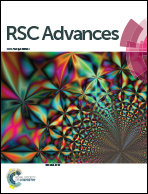A commercial approach for the fabrication of bulk and nano phosphors converted into highly efficient white LEDs†
Abstract
Herein, we report a strategy to synthesize a highly efficient yellow light emitting Y3−xAl5O12:Cex (x = 0.03 to 0.3) based bulk as well as nano (rod-shaped) phosphors, which are the main component of solid state white light-emitting diodes (WLEDs). The as-synthesized phosphors were well characterized by several experimental techniques related to material characterization and spectroscopy. The bulk and nano phosphors emit with maximum photoluminescence intensities at 549 and 530 nm, respectively, upon excitation at a wavelength of 468 nm. These phosphors exhibit higher photoluminescence intensity as compared to commercially available bulk phosphors coated on WLED strips. Moreover, the integration of commercially available InGaN blue LED strips with the synthesized bulk and nano phosphors demonstrates better CIE coordinates and lower colour temperature with high brightness (>81% quantum yield) compared to commercially available WLED-based strips, lanterns and torches. These highly efficient light-emitting phosphors are a feasible candidate for potential use in commercial WLED applications.


 Please wait while we load your content...
Please wait while we load your content...